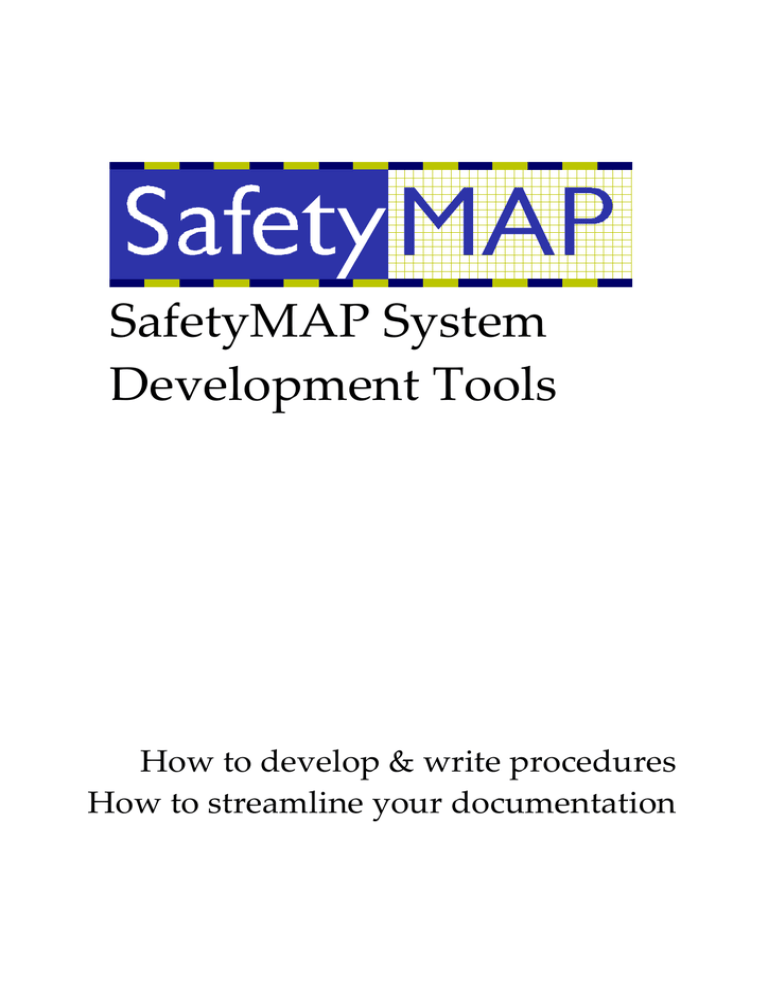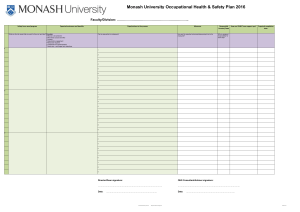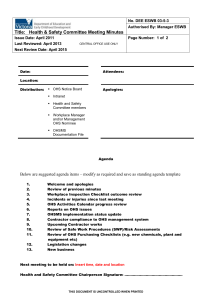SafetyMAP System Development tools
advertisement

SafetyMAP System Development Tools How to develop & write procedures How to streamline your documentation How to develop and write procedures Introduction After conducting an assessment using the “SafetyMAP Initial Level or Advanced Level User Guide” you may have established a need to develop a procedure to cover a certain aspect at you workplace e.g. a procedure to cover the requirements of a regular inspection of the workplace. The following provides guidance on how to go about writing a procedure and how to avoid excessive documentation. The last three pages of this document shows a flowchart indicating the steps involved in the development, authorisation and publication of a procedure, followed by a suggested format for a procedure. What are procedures? A procedure is a written statement that answers the following questions: ; WHAT has to be done? ; HOW does it have to be done? ; WHO has to do it? ; WHEN does it have to be done? The WHAT tells us what standards have to be achieved. The HOW tells us the method or steps to be followed. The WHO tells us the role of various people, their responsibilities and required skills. The WHEN tells us the times at which the procedure should be followed and when it needs to be reviewed. What is the difference between a policy and a procedure? A policy is a statement about the objectives that the organization would like to achieve. An “injury free workplace”, a “smoke free workplace” or a “violence free workplace” are examples of objectives. A policy usually sets out a timetable for achievement of the objective, the general steps required and the expectations of everyone subject to the policy. A procedure will be part of the way of putting the policy into practice. 2 Are there procedures and procedures? Yes. In organizations with formal OHS management systems there will be procedures about how each part of the system operates. For example there may be a general purchasing procedure that incorporates OHS requirements. In fact there will usually be a procedure about how to write a procedure. These are sometimes confused with “safe working procedures” or “standard operating procedures” which normally address specific hazards. A confined space entry procedure for example, will specify requirements and a sign in‐ sign out permit system. Some organisations will combine these types of procedures but it is a good practice to target information to specific groups. Organisations setting up a basic OHS program should concentrate on procedures that are required to manage workplace hazards. How to develop procedures? ; List hazards and issues The first step is to list the hazards and issues that are important to manage if health and safety is to be assured. This might result in a list covering hazards such as chemicals, plant and fire and other issues such as contractors and purchasing. ; Narrow down the field to big impact issues Discussion with employees, use of relevant information and a review of your workplace experience will narrow down the areas that are likely to have most impact. ; Decide if the procedure needs to be written down This is important if you want to keep paperwork to a minimum. There may be some hazards that signs or symbols may adequately communicate the procedure. This approach is usually only suitable for prohibitions that affect everyone such as “no smoking in the area”. The other consideration should be the likely effectiveness of a written procedure given the literacy profile of your workplace. If a verbal method of getting things done safely is the best method then this should be used but there will still be a requirement for the “script” to be kept by a supervisor or manager. Some tests for the need for a written procedure include: o Are you confident a verbal system will be reliable? o How are you going to instruct new employees? 3 o How are you going to satisfy a company that engages you as a contractor that you can manage health and safety? o How are you going to satisfy a WorkSafe inspector your employees know what they should be doing? o How do you expect employees to follow rules if they are not written down? o How do you expect to impose discipline if there are no clear rules? ; Prepare procedures for priority issues Keeping in mind the considerations above a procedure can be developed using the WHAT, HOW, WHO, WHEN structure. This can be done as a group by simple going through the steps with the work group. The format for the written procedure should meet effective workplace communication standards. The following “plain English” principles are recommended: ; Get straight to the point ; Use words familiar to the work group ; Keep sentences short and simple ; Use the active voice where possible ; Make the procedures “talk” to the users, e.g. use “you” and “we” ; Use conversational English These plain English principles apply also to translating procedures to any other languages that might be used in the workplace. ; “Road test” procedures with users Participation of users in developing procedures is important for the message to be understood and owned by those who are subject to the procedure. Testing the procedure with work groups and getting their comments on how well it works is essential before a final version is released. This can be done through OHS committees, HSR’s, work groups or team meetings. Making sure procedures are doing the job It is recommended that a periodic check of procedures be made to make sure they are achieving the desired result. It is of no comfort to find out after an incident or injury that the procedure was inadequate. If your procedures are primarily directed at reducing risks (i.e. safe operating procedure type) you should focus on outcomes. Has the procedure been effective in protecting people? This can be established by measuring risks (e.g. level of noise), checking reports (e.g. injuries, incidents) and talking to employees. 4 If your procedures are part of a more formal OHS management system (i.e. procedures about the system) you will need to audit whether procedures are being followed and look at specific conditions set out in the procedure. These include: • Is the procedure up to date? • Is the procedure authorised by the appropriate manager? • Are there records kept? • Has the procedure been reviewed as required? Examples of these types of procedure would be how records are kept, how legislation is kept up to date and how incidents are investigated. The best method of reviewing these is by an audit, which is a systematic method of establishing whether activities and results are in line with defined procedures. 5 How to streamline your documentation If you developed a documented OHS management system part of the review process should be make sure the system is not being clogged by little used paperwork. Over‐documentation can occur when you have a large organization and also where you may have several formal management systems operating. Quality systems, environmental management systems, health care accreditation systems and food safety systems may all operate along with an OHS management system. Unless carefully managed this may result in procedure overload. Warning signs of over‐documentation ; There is more time and money spent writing procedures and producing manuals than there is on checking whether desired results are being achieved ; There are documentation specialists in the organization who don’t like other people, particularly users “messing around with their format” ; Line managers and supervisors who complain of being bombarded with procedures ; Procedures for which there are little or no auditable records suggesting lack of importance ; Procedures for which there are many auditable records but little evidence of action to remedy the problem ; Detailed documentation of the visible and obvious parts of the system (e.g. detailed records of when the first aid kit was stocked) and little on the less visible but more important parts (e.g. results of atmospheric monitoring) Ways of reducing the number and complexity of procedures? ; Write procedures relevant to the business risks rather than to match a system standard Procedures should cover the priority health and safety risk in the workplace not be prepared to match up a requirement in a system standard. SafetyMAP, AS 4801 or any other management standard sets out a series of core elements and one of the mistakes is to work through the standard from top to bottom and prepare matching procedures. This approach results in systems in which no one is convinced about the need for the procedure and it inevitably falls into disuse. If the only reason you have a procedure is “because the auditor said we needed one” this should be a warning sign of procedure over‐load. 6 Concentrating on procedures that have direct application to the health and safety issues everyone understands and considers important will give the documentation the credibility it deserves. Matters considered to be low risk or low priority will be ignored and seen as wasteful paperwork. If the issue really is important and high risk but is not recognised as such procedures will not solve the problem. Education, information and training will all be required before any procedure is likely to have any impact. ; Provide only what people need to do their part of the job Some procedures directly affect certain people and jobs and where possible that is all they should have to manage. In a management system there are many procedures that can be seen as “back office” procedures designed to keep the process ticking over. It is not important for a first line supervisor to know what format training records should be kept in or to know the system for keeping legislation up to date. Use of a “further information” link on any procedure is recommended so that if anyone wishes to look at back office procedures they can. Properly targeted information will provide people with what they need to know to do their job not the workings of the whole system. ; Regularly seek feedback and cull excess documentation One of the best tests of a procedure is to understand why people do not follow or use the procedure. Normally there are 5 reasons why a procedure is not followed: o The procedure is not clear or understood o The users do not believe the procedure is necessary o The users do not think the procedure deals with everyone fairly o The users believe the procedure imposes costs that are not justifiable (e.g. time, effort and money) o The users do not see any penalties to deter them from ignoring the procedure If these reasons are behind the lack of compliance you should amend and cull procedures accordingly. 7 DEVELOPMENT, AUTHORISATION & PUBLICATION OF OHS PROCEDURES YOUR LOGO Manager Health and Safety reviews proposal or initiates own proposal Need for new procedure identified With recommendation Originator advised. No further action Proposal rejected Relevant Health & Safety Committee considers proposal (or initiates its own) Proposal approved Originator advised Manager Health and Safety drafts procedure in consultation with relevant technical expertise Relevant Health & Safety Committee considers draft, then draft is placed in Bulletin Board for all staff comment Procedure not approved Procedures edited to incorporate comments and endorsed by Health and Safety Committees Procedure approved Manager Health and Safety arranges for OHS Manual to be updated and new procedure communicated to employees. Chief Executive authorises procedure Controlled copy. Any photocopies are uncontrolled. Authorised by: Your CEO etc. Effective Date: 1 July 2008 Page 1 of 3 Next Review: July 2010 DEVELOPMENT, AUTHORISATION & PUBLICATION OF OHS PROCEDURES YOUR LOGO PURPOSE To establish service standards for the development, authorisation and publication of health and safety procedures for Company XYZ. SCOPE This procedure applies to all persons involved in the development, authorisation and publication of health and safety procedures for Company XYZ’s Occupational Health and Safety Manual. DEFINITIONS (if necessary) PROCEDURE RESPONSIBILITIES DESCRIPTION 1. Determining the need for or review of health and safety procedures All employees 1.1. Any employee, manager, Health and Safety Committee member or the Manager Health and Safety may initiate the need for, or revision of, health and safety procedures. All employees 1.2. Where an employee identifies the need for a new procedure or the revision of an existing procedure they should communicate this to the Manager Health and Safety. Manager Health and Safety 1.3. The Manager Health and Safety will review requests received and make a recommendation to the Health and Safety Committee based on information gathered about the issue, risk assessment, prior incident experience, etc. A draft may be presented to the Committee for discussion. H&S Committee 1.4. If it is decided by the Committee that a new procedure or modification to an existing procedure is not warranted, the Health and Safety Committee will then consider what alternative steps, if any, shall be taken to deal with the issue. Manager Health and Safety 1.5. The Manager Health and Safety shall advise the originating employee of the Health and Safety Committee’s decision, and the reasons for the decision. Manager Health and Safety 1.6. When required, technical expertise will be obtained as appropriate, from within or external to Company XYZ. Controlled copy. Any photocopies are uncontrolled. Authorised by: Your CEO etc. Effective Date: 1 July 2008 Page 2 of 3 Next Review: July 2010 DEVELOPMENT, AUTHORISATION & PUBLICATION OF OHS PROCEDURES YOUR LOGO 2. Authorisation of the Procedure Manager Health and Safety 2.1. When a final draft has been agreed by the Health and Safety Committee, the draft will be distributed for comment, for a period of not less than 14 days, on the Bulletin Board. All staff will be advised of this via email. All Employees 2.2. Any comments shall be forwarded to the Manager Health and Safety by the specified date. Manager Health and Safety 2.3. The comments will be collated and reviewed, by the Manager Health and Safety and modifications made to the final draft prior to it being redistributed to the Health and Safety Committee Members. Health and Safety Committee 2.4. The Health and Safety Committee will endorse the final draft. Manager Health and Safety 2.5. Draft procedures endorsed by the Health and Safety Committee, shall be forwarded to the Chief Executive for formal authorization. Manager Health and Safety 2.6. When a procedure has been authorised, it will be included in the XYZ Health and Safety Manual. Employees will be notified of the new/modified procedure. Manager Health and Safety 2.7. The Company XYZ Health and Safety Manual shall contain the controlled documents and any photocopies will be uncontrolled documents. Manager Health and Safety 2.8. The original of the procedure, signed by the Chief Executive, will be kept on file for audit and reference purposes. Chief Executive ATTACHMENTS None REFERENCED DOCUMENTS Occupational Health and Safety Act 2004 Controlled copy. Any photocopies are uncontrolled. Authorised by: Your CEO etc. Effective Date: 1 July 2008 Page 3 of 3 Next Review: July 2010





